
Sailboat cockpits will happily collect spaghetti if we let them, each sheet, halyard, and new control line adding to the confusion. The chaos is not just unsightly, it is inefficient, which is why race boats have a bag or hook for every line. Other than neatly flaking a lazy sheet in the corner or throwing halyard tails down the companionway (fast for racers), there are four basic options: coil and hang over a winch, secure the coil with a choker and hang over a hook, hang the coil from a hook that includes a captive line, or use a sheet and halyard bag. We use all four.
What We Tested
We’ve had hooks on the boats for decades and have never broken one that was properly mounted. We’ve used bags on the foredeck, where a hook would not be sufficiently secure. We’ve even tied seldom-used lines to the deck using a pad eye with a captive tie cord. We’ve been adding controls and tweaks to our F-24. The original owner’s hooks have fallen off, and the clutter in the cockpit and lockers has gotten out of hand, so we decided to add a few new hooks and take inventory of our past experiences, including both hooks and sheet bags. See “Sailboat Accessory Hooks” for results of our strength testing. We have had glued-on hooks come off many times, including practically every previous owner effort.
Hang From a Winch
Coiling line and hanging on a winch looks neat at the dock, but it really only works for the line primarily used on that winch. Jib sheets hang from primaries, reacher or spinnaker sheets from secondaries. Since you will often remove and flake these as soon as you board, the main purpose is to get them off the seats and reduce mildew. Any other line will have to be removed before sailing. If you have a row of jammers in front of the winch you will need something for the other lines.

Lines can also be coiled and hung from the lifelines. While this is fine at dock, they swing around underway and are often out of reach. This is rarely a useful option on a multihull.
Hang From a Hook
You can easily coil the line securely and luggage-tie a 1-foot bight around the coil and hang it from a hook. We like this method for lockers, because once secured, the coil can be handled freely and stowed or recovered from deep in a locker with one hand. Multiple coils can hang from a single hook. In fact, we designed a special recurved hook just for this purpose. It is secure in the most violent weather and will not snag or damage sails, other ropes, or clothing. It keeps the rope from piling up on the locker floor. But we are not fond of hooks on deck, because sooner or later they will snag something they shouldn’t.
Coil and Hang From Captive Loop
To hang a rope from a captive loop hanger, pass the loop through the center of the coiled rope and around the coils, and park the loop on the hook. We much prefer “hooks” that are have clips or covers so that they can’t snag other lines.
You have to remove some captive loop hangers to replace the line. Inside a locker, a bungee cord can last for decades, but in the sun, two years is a full life. This means any holes securing these hangers should be well sealed against any water intrusion, or you will surely introduce a leak which can damage core. Bungee gives the illusion of greater security than cord, but it does not last and is a little harder to work with, often requiring two hands. Ideally, the hook-hanger should be one that makes it easy to adjust the cord length to fit the coil.
Ronstan Shock Cord Line Hanger
We’ve used Ronstan hangers in lockers, and they have proven quite strong. We’re not fans of screw-on fasteners, the hook can snag other lines, and it must be removed to adjust or replace the cord. Still, they are durable and versatile. $10 for two.


Schaefer Handie Hanger
Instead of a hook, the Handie Hanger features a cord with the ball on the end, which drops into a slot. The cord is easily adjusted or replaced without removing the mounting block, and the design is virtually snag proof. The only downside is the requirement for screw-in fasteners, although a rail clamp is included. $22 for two.
Poliglow Universal Stainless Steel Hanger

This is similar to the Handie Hook, but in stainless. We examined this in a previous review—see “Universal Hanger“. It’s specifically designed for rail mount. $13 for one.
Button-Line Holder, United Yacht Manufacturing

This device’s very low profile makes it almost impossible to snag anything. A large area of high-bond, self-adhesive tape makes them permanent without drilling a hole. The captive line can be adjusted or replaced in minutes without removing the mount. You just poke the line from below up to access the stopper knot.
They also make a small size, but because the surface area is smaller, it requires a fastener. (You can also put a screw through the large Button Holder, but there is no need). $7.50 each.
Soft Shackles, Knotted Strops, or Loops With Toggles
Secured by eye straps or a mounting board, soft shackles are strong, cheap, robust, and pretty easy to work with. They will work well in an easy-to-reach locker. We have used loops with toggles to secure seldom-used reefing lines to the deck near the mast.
Rope Rack
We’ve seen home-made racks consisting of a row of slots in a thin board, similar to the Handie Hanger. Mounted on spacers, the board stands off from the bulkhead. A short rope or shock cord with knots in each end, is used to secure the lines. Simply slide the knots into the slot, as with the Poliglow Universal hanger—see this how-to from eOceanic.
Sheet and Halyard Bags
Bags are handy for lines that are used frequently, because the line does not have to be uncoiled and flaked before use. Bags are also good for lines that are very seldom used (halyards for furling sails). Lines dry more slowly than coils hanging in the air and are slightly more prone to mildew.
Fiberglass boxes are pretty, smoother, and the lines play out faster, but they are hard to lean against, and the lines dry more slowly, promoting mildew. The open mouths give better access and are nice on multihulls, but the more closed mouth of a canvas bag is more secure when waves roll across the deck or in a knockdown. Canvas bags with closing mouths or zippers are required near the mast and any area on deck that can be washed by waves.
If the line is long and used frequently a separate bag is best; long lines can tangle around each other and you may have to pull it all out and flake it for a for a fast release anyway (see “Stopping Mainsheet Twist”). Short tails from control lines can share a bag. A single large bag can, of course, be divided.
Do you need a separate bag (or compartment) for each tail, or can they share? In our experience, sharing is fine for shorter lines that don’t have to run out fast, such as reefing tails, mainsail outhauls, and less used tweaks, but sheets and halyards are better separated.
Blue Performance Mast Sheet Bag

Our PDQ test boat had four halyards, three reefs, and a topping lift. We keep the reefs, furling genoa halyard, and topping lift tails coiled and securely lashed to the deck since they are not frequently used. However, the main and spinnaker halyard tails needed a safe home.
The Blue Performance Mast Sheet Bag (really more of a halyard bag) has been serving well for six years. Other than a little fading, performance has been faultless. The straps are easy to adjust and have remained secure. The bottom of our bag rests on the deck; if it were on the mast one of the straps would need a stop to prevent sliding downwards.
The zipper required lubrication after five years, but has been fine for a year since. The Velcro tabs on the flaps are holding up well, and none of the stitching is worn. The medium size bag easily holds the genoa halyard tail (55-ft. x ½-in. line) and topping lift tail (10-ft. x 3/8-in. line), leaving room in the top for a convenient winch handle. These are available in small ($65, 5.9 in. x 4.3 in. x 17.7 in.), medium ($76, 6.9 in. x 5.1 in. x 23.6 in.), and large ($94, 8 in. x 5.9 in. x 27.6 in.).
DIY Sheet Bags
You can sew simple bags from Sunbrella or trampoline mesh, and they will last long. Add polyethylene (thin cutting board) stiffeners into the lip seam to hold it open. If you would like to test a bag’s utility in a certain location before investing a lot of time and money, get a cheap closet shoe bag, cut it into sections, and mount these with Velcro. They won’t last, but they will help you to buy or sew just what you need.
You can sew the bags directly to multihull tramps, or attach them with lines. We’ve used these bags on our tramps for halyard tails, downhauls, and anchoring bridles. We added these to our Stiletto tramp, and when it was due for replacement, the canvas maker integrated them into the design.
Rigid, or semi-rigid bins can also be fabricated from plywood, fiberglass, or a combination. We’ve seen several sailors repurpose a water jerry can for stowing a stern anchor rode. You simply cutout the spout, leaving a hole big enough for the rode. Unlike a bucket or crate, it has a flatter shape and lashes neatly to the sternrail.
Summary
Proper sheet storage is often overlooked on cruising boats, with only the racers taking it seriously. We think we can learn from them.
On our F-24 and Yankee 30 test boats, we use a variety of methods, each selected for its best use. We like our DIY hooks in lockers for coils and gear secure with chokers. We can load a lot on them securely.
We like the United Yacht Manufacturing Button Line Holders (captive loop) for quick one-handed storage of frequently used lines in the cockpit, or in places where bag won’t fit.
We like sheet bags anywhere they fit, for long tails, and on deck where waves and spray are an issue. We still throw halyard tails down the companionway when day sailing. We’ve eliminated most of the spaghetti and we don’t miss the tripping and tangles.
Contacts
Schaefer, www.schaefermarine.com
Ronstan, www.ronstan.com
Poliglow, www.poliglow.com
United Yacht Manufacturing, www.unitedyachting.com
VALUE GUIDE: LINE HANGERS
| MANUFACTURER | RONSTAN | SCHAEFER | UNITED YACHT MANUFACTURING | POLIGLOW | DIY | DIY |
|---|---|---|---|---|---|---|
| PRODUCT | Shock Cord Line Hanger | Handie Hook | Button Line Holder (Large) | Universal Hanger | Rope Rack | Aluminum Hook |
| MATERIAL | Plastic | Plastic | Plastic | Stainless steel | Wood, Azek, Starboard, etc. | Aluminum Hook |
| REPLACEABLE CORD (WITHOUT UNINSTALLING) | No | Yes | Yes | No | Yes | Yes |
| SNAG POTENTIAL | Moderate | None | None | None | None | Minimal |
| DRILLING REQUIRED | Yes | Yes, but optional rail mount included | No | No, rail mount only | Yes | Yes |
| PRICE | $10 for two | $22 for two | $7.50 | $13 | ~$10 (varies by material) | $1 with cord |
Sheetbags are not an instant cure for cockpit spaghetti. Stuffing several long tails into one large bag can actually promote tangling rather than prevent it. Hooks are handy, but can snag lines—not a problem inside lockers.
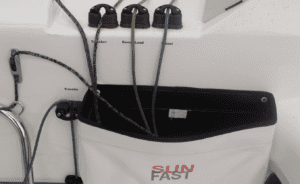
1. Multiple tails dumping into one back will work fine if the tails are short. Otherwise, a spaghetti soup will ensue.

2. This bag reduces the clutter, but pulling a line out may result in a worse mess. Lines left in a bag will tend to grow mildew more readily than those that are aired out when the boat is idle.
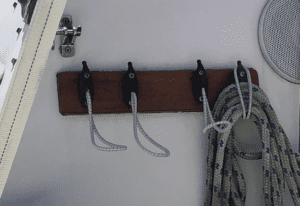
3. Ronstan hooks are strong, but they tend to snag lines in the cockpit and you have to remove them to replace the shock cord.
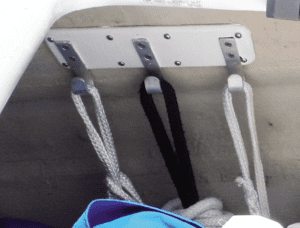
4. DIY hooks mounted on an aluminum strip provide a modular rack of hooks that can be removed. Turned inward, the hooks are strong and snag-resistant.
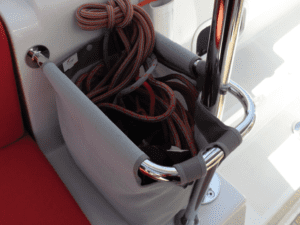
5. A stainless steel and fabric bin on this catamaran provides a semi-permanent place for sheets.

6. The Blue Performance bag keeps halyards (and winch handle) at the mast. Reefing lines are secured to deck padeyes by loops with toggles.
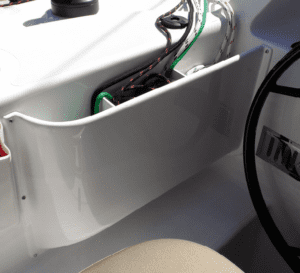
7. The sheet box on this Seawind catamaran has handy dividers.

Inexpensive, easy to install and service, stick-on button and line hangers proved to be an easy, affordable, and durable option for organizing lines. Ours have gone through several seasons without cracking or fading.

1. The high-strength peel-and-stick tape has held through rain, cold, freezing winters and hot summers.

2. The supporting line is easily replaced or adjusted with out having to remove the button. The line can be released with one hand.
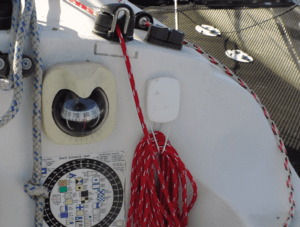
3. The buttons have a clean look and are unobtrusive in the cockpit. Here it secures a reacher furling-line tail.

This article was first published 13 December 2022 and has been updated.







































“Reefing lines are secured to deck padeyes by loops with toggles.”
How so? Is the reefing line a separate line not attached to the sail clew reef cringles on the sail? – Thanks – Dennis
The tails of the reefing lines are secured to the deck.